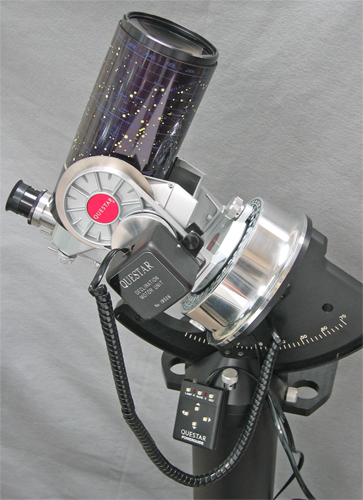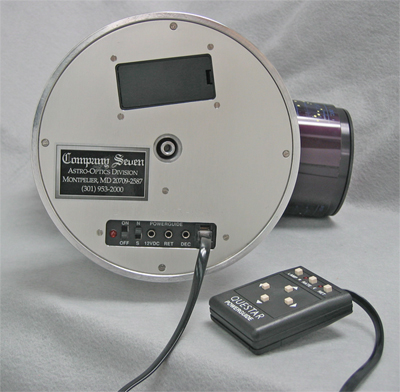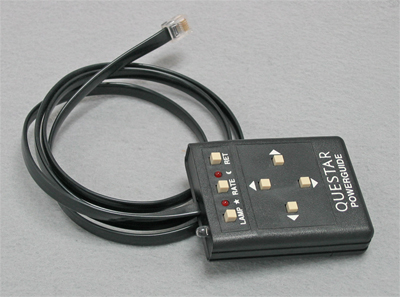Questar Distribution
![]() News
News ![]() Notes & Interesting Articles
Notes & Interesting Articles ![]() Overview
Overview ![]() Pricing
Pricing ![]() Products
Products ![]() Service or Repair
Service or Repair
Questar Telescopes ![]() LD Surveillance Systems
LD Surveillance Systems ![]() LD Microscopes
LD Microscopes ![]() Accessories
Accessories

QUESTAR POWERGUIDE I DRIVE & CORRECTOR
This accessory made by Questar has been discontinued and since replaced by the Powerguide II.This article is provided as a courtesy by Company Seven for those customers who have helped to keep us in business.
 The original internal Powerguide system of the 1980's and it's successor the Powerguide II are each an electronic regulated drive and corrector system powered by one 9 volt battery that allows the user to operate the Questar at a precise Sidereal or Lunar rate anywhere in the world - north or south hemispheres, completely independent of wall current or other external power sources. The Powerguide also provides the means to vary the rotation speed of the Right Ascension motor to make fine tracking adjustments. The internal Powerguide systems are arguably the most important innovation that has been developed for the Questar since its introduction.
The original internal Powerguide system of the 1980's and it's successor the Powerguide II are each an electronic regulated drive and corrector system powered by one 9 volt battery that allows the user to operate the Questar at a precise Sidereal or Lunar rate anywhere in the world - north or south hemispheres, completely independent of wall current or other external power sources. The Powerguide also provides the means to vary the rotation speed of the Right Ascension motor to make fine tracking adjustments. The internal Powerguide systems are arguably the most important innovation that has been developed for the Questar since its introduction.
Above page title: Questar logo used by the company through the 1980's into the 1990's.
Background The Questar 3-½ and Questar Seven telescope drive fork bases are furnished with a fork style drive base with a set of three very lightweight alloy legs. The legs thread into the drive base at two points on the side, and one at the bottom to form a tripod that is adjustable for latitude. This tripod permits the telescope to operate off of a table top. Alternatively, the telescope may be Pole Aligned atop an optional field tripod such as the Questar Tristand. The fork mount is normally provided with a 120 Volt A.C. (or 220 volt optional) motor system with an AC power cord. The AC cord plugs into a wall outlet and this starts the fork tracking at a Sidereal rate that permits accurate tracking of stars, planets and most other celestial objects as the Earth rotates. Since the motor is a non reversible synchronous motor one must specify either North or South Hemisphere when ordering this drive system. This basic arrangement is completely satisfactory for a person who operates the telescope for viewing only from one location that has A.C. power such as at a school, or on a home deck.
Right: Questar Duplex with Powerguide I, optional Motorized Declination Drive and Questar Tristand (151,558 bytes).
Click image to see enlarged view (332,338 bytes).
Powerguide I is the optional quartz crystal frequency regulated drive system for the Questar. A drive base equipped with Powerguide I incorporates a servo motor with drive corrector circuitry powered by a common alkaline 9 Volt D.C. battery housed in the hand-held controller. The endurance of this highly efficient system provides up to twenty four (24) hours of service and nearly double that time with a long life lithium 9 volt battery. This capability to operate from a battery eliminates the need to be located near an AC power source.


The hand-held control paddle controls all functions including the selection of drive rate (Sidereal or Lunar), fine speed correction changes of ±1.4 or 10X Sidereal. All control is done with the "On Off" switch and four (E-W-N-S-) push buttons; there are no switches on the drive base - all is on the hand paddle that plugs into the bottom of the base. An internal Quartz reference circuit continuously checks motor speed every 0.6 Arc Sec. and adjusts it as necessary. But the most important aspects of this option are that it frees a person to travel around the world, to the North or South Hemisphere independent of external power supplies.
The development of the 9 volt Powerguide systems was accompanied by the introduction of an optional Motorized Declination Assembly for the Questar 3-½ Fork. This accessory includes a Declination Hand Control wheel that replaces the original, and the Motor and Support Frame that is attached onto the Fork Tine meshing with the new Declination Hand Control wheel. The only Questar 3-½ Motorized Declination Drive and the Questar Seven Motorized Declination Drive options are for use only with those Questar Fork Mounts that incorporate the Powerguide II drive and control system. There is no longer any Declination Motor made that is compatible with this original Powerguide system.
 The Powerguide I consists of several components:
The Powerguide I consists of several components:
- Power and Signal Cable
- Powerguide I Control Panel
- Battery Housing in telescope base
- Powerguide I Hand Held Controller
- 9 Volt Alkaline Battery (Lithium battery for longer life or operation in cold climates)
Right: Questar Powerguide I Control Panel and Hand Control. The rectangular black plastic lid covers the battery compartment. Controls left to right: Power light, switches for On-Off, N-S, and input for 12 vdc, outputs for optional illuminated reticle and Declination Motor (110,214 bytes).
Click image to see enlarged view (234,742 bytes).
Set up and Operation:
- Pole Align the Questar Fork Mount. The drive will not track accurately without the mount being reasonably well oriented to the celestial pole.
- Connect the provided six pin modular cable attached to the Powerguide I Hand Control Paddle into the jack at the base of the Fork Mount.
- For Northern Hemisphere operation slide the N-S select switch to "N". The red LED should light indicating proper operation. For reversed motor operation in the Southern Hemisphere operation slide the N-S select switch to "S".
- Turn on by sliding the power switch to "ON".
- Sidereal is the default tracking rate at startup, the red LED above the star image on the hand paddle lights when this rate is selected. To set the R.A. tracking to the slightly faster Lunar rates press the "Rate" button on the Hand Control Paddle, the red LED above the crescent moon image on the hand paddle lights when this rate is selected. To resume Sidereal rate, push the "Rate" button once.
- Right Ascension functions are controlled by the left (West) and right (East) push buttons, while Declination with the optional Declination Motor are controlled by up and down buttons. Note for Southern Hemisphere operation, these directions will appear reversed.
- For the convenience of users in the Southern Hemisphere, or those whose wish to improve their sense of guiding direction using some accessories, it is possible to reverse the Guiding Buttons. Unscrew the base cover plate to access the reversing switches. Dip switch #1 reverses the Declination, while #2 reverses the Right Ascension buttons. WARNING! these components are sensitive to electrostatic discharge and so appropriate precautions are a must; when in doubt contact Company Seven for service or advice.
- Pressing either the North, South or West buttons accelerates the R.A. or Declination drive motors to fine adjust centering a target by moving at 1.4 x the standard Sidereal rate, a 35% speed increase. Note pressing the East button stops the R.A. drive motor so that the Earth's rotation causes the object to drift apparently to the East, releasing the East button resumes tracking. These functions are reversed for Southern Hemisphere operations.
- Pressing the North, South, East or West buttons while then pressing and holding the opposite direction push button accelerates the R.A. or Declination drive motors to 10 x the standard Sidereal rate, a 1000% speed increase. This is useful for initial centering of a target that is far off center, or for perusing through an area of sky congested with targets.
- The Hand Control's "RET" button activates the power outlet (at the Control Panel) for an optional illuminated reticle eyepiece. The intensity may be adjusted in four steps by repeatedly pushing the "RET" button.
- The Hand Control's "LAMP" button activates power to the LED atop the Hand Control for the user's convenience. The intensity may be adjusted in four steps by repeatedly pushing the "RET" button. Note that rather than using this to deplete the internal battery, one may do better to use a portable red LED flashlight such as our Skylite.
- When the battery is depleted to about 6 volts (15 to 20% of capacity) then the red LED on the Base and by the "RATE" button of the Hand Control will begin to flash.
- For long term operations in locations with access to AC power, you may use the provided AC to 9 volt power supply to feed the "12VDC" receptacle at the Control Panel.
 Note: Powerguide I is expressly designed for use only with the Powerguide I Motorized Declination Drive and not with that of the later Powerguide II. Any attempt to use the Powerguide I or its Motorized Declination Drive with any other system is likely to result in damage to the motors and possibly to the controller as well.
Note: Powerguide I is expressly designed for use only with the Powerguide I Motorized Declination Drive and not with that of the later Powerguide II. Any attempt to use the Powerguide I or its Motorized Declination Drive with any other system is likely to result in damage to the motors and possibly to the controller as well.
Right: Questar Powerguide I hand held control paddle (85,603 bytes).
Click image to see enlarged view (213,620 bytes).
Company Seven recommends this be used as a fine positioning aid, it is not designed as a slewing motor to drive the telescope back and forth across large areas of the sky.
Furthermore, if you do plan to store away the telescope for extended periods then we recommend removing the battery, or storing it separately within a Zip-Loc style bag. In this way if the battery leaks it will not corrode the internal portions of the telescope base. When storing the telescope over long periods, particularly in humid climates, then it is a good practice to store the telescope with desiccant in the carrying case. Also periodically turn on the Powerguide I drive and allow the motor to run for several hours, this will help to prevent oxidation from accumulating on the motor brushes thereby increasing reliability. Do not be concerned about running the Powerguide I for too long, we have tested the motor of one unit by running it continuously for more than two years (>17,530 hours!) before we finally turned off its power supply.
| Motor Type | Digital Feedback Servo |
| Motor Max. Torque | 100 oz. |
| Power Requirement | 9 Volt D.C. |
| AC Adapter Provided | 115 VAC to 9 Volt D.C. |
| Polarity Protection | Yes |
| Nominal Current Draw | 1.7 milliamp |
| Speeds | 1.4X (35%) or 10X (1000%) Sidereal Rate |
| Endurance | 24 Hours with Alkaline, 40 hours with Lithium battery |
| Control Cable Connector | Modular 6 pin (RJ12) |
| Hand Control Dimensions | 2.95 x 2.2 x 0.8 inch / 75 x 55.8 x 20.1 mm |
| Hand Control Weight (with battery) | 1.8 oz. / 54 Gr. |
We invite you to visit our showroom near Washington, D.C. to see a Questar first hand. Or contact us by E-Mail to info@company7.com, or by telephone at 301-953-2000. The showroom is open Monday to Friday 11 am to 6 pm, Saturday 11 am to 5 pm. We are closed on Sundays, on U.S. Holidays, and from 25 December through 1 January inclusive.
Contents Copyright 1994-2006 Company Seven All Rights Reserved

